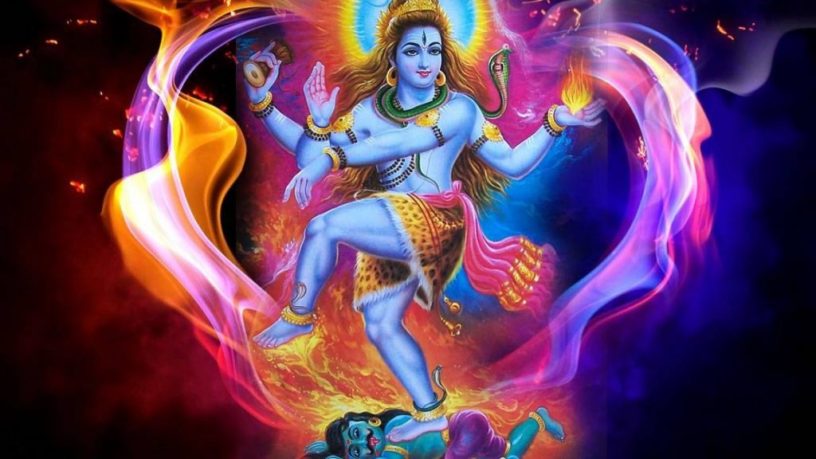Paramacharya of Swaha, Pt. Hardeo Persad
Nirguna Brahman is God who is without qualities. He is unconditioned, without form, has no beginning, no middle and no end. He is beyond all limitations of form, time and space. He is the Supreme cause. He is the infinite consciousness that pervades all creation. He is the substratum of all things: everything comes from Him and He is in everything. He is described as being omniscient, all powerful and all knowing. He is complete in Himself.
This unmanifest Brahman, or Paramshiva, through his dynamic power of consciousness or Shakti, creates a universal evolutionary process with conditioned forms of Himself, descending into subtle energy forms and later to gross matter. His many names and emblems denote the qualities attributed to Him, and at the same time, refer to His infinite nature.
Hindu scriptures describe the significance of Shiva during the churning of the ocean. Once, the Devtas and asurs churned the ocean of milk with the mountain Mandara, using the serpent Vasuki as a churning cord. Fourteen articles emerged from the ocean, one of which was deadly poison. Shivaji was asked to save them from the poison, without any harmful effect to Himself or them. He was then called, Neela kanth, the Blue-Throated One. It is the name attributed to Him when He destroys the poisons, negativities and distresses in one’s life. This story is highly symbolic on many levels, and represents the churning of the mind.
Shivaji represents the state of dispassion, vairaagya. This is one of the four qualities necessary for freedom from bondage. As a prelude to dispassion, one experiences disgust with the negativities in the world. As we turn away from these negativities, we develop vairaagya. The most deadly poison in the world is materialism, which consumes humans, causing enmity and strife. When we worship Shivaji conscientiously, we develop the power of dispassion. It consumes materialism, which is ineffective against spirituality. We must remember that at the end of life, we do not carry our material gains with us. In today’s world, our peace and happiness are temporary. At times, we gravitate towards the pleasant instead of the good due to the absence of vairaagya. We cannot attain enduring peace or spiritual perfection in this life without developing the power of tyaag, dispassion. Therefore, we should worship Shivaji who represents goodness, auspiciousness and detachment.
It is said that Shiv Shankar meditates for thousands of years. His long hair is tied in matted locks. This symbolises the control of the praan vayus or five vital life forces that animate the metabolic activities of our body. The five major praana vayus are praan (inhalation), apaan (exhalation, elimination), samaan (digestion), vyaan (circulation) and udaan (rising air) vayu, and the five minor ones: naag (burping), kurma (blinking), krukara (sneezing), dhananjaya (opening and closing of heart valves) and devadutt (yawning). When Bhagavan Shankar practises dhyaan (meditation), tying his hair in matted locks symbolises the control of the praan vayus, or bodily activities, so that they do not distract from his meditation.
Similarly, we are advised to fast before pujas and other religious occasions as it gives some control over the bodily activities that distract from prayer. It is only when these vital airs are firmly managed that the body becomes stable and the devotee is able to transcend the physical plane of existence and delve deep within his consciousness. The various forms of religious discipline are also symbolised by Shiva, who is the master of his body, sitting in absorption on the Self without distraction. Ganga, symbolising the stream of devotion, flows from his matted locks. At a deeper level, when all the metabolic activities of the body are controlled, we can meditate deeply and devotion flows.
Shivaji also carries the damaru (drum) which represents rhythm. Shivaji is the Lord of rhythm; He is the perfect artiste. The damaru also symbolises the rhythm of manifestation with which He creates. It also represents sound as the first element in an unfolding universe. It is said that emanating out of the damaru is the Maheshwar Sutra, the Law of Creation. Everything in this world functions according to a rhythm and a cycle.
The cobra that adorns His neck represents the individual ego, which could be destructive if left unchecked. We cannot destroy the individual ego but we must transform it from an association with the materialistic state to identification with the Cosmic Ego. The snake is naaga bhushan, a jewel, on the neck of Bhagavan Shankar. It is the individual ego transformed, adorning the Lord’s cosmic body. One must identify with that Supreme spirit, Chidananda rupoham, shivoham, shivoham.
Shiva Bhagavan, in this finite form, possesses numerous attributes that characterise Him as the Lord of all creation, the Unchangeable One, the One who is the known, the unknown and beyond the unknown. The universe and everything in it are in Him, yet He is beyond all things. He is Brahman, out of which all things emanate and into which all things merge. He is the basis of all creation.



